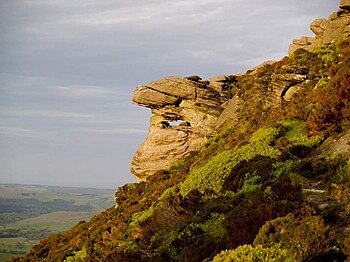Simonside Hills
The Simonside Hills are a modest but spectacular range of hills in Northumberland, near the town of Rothbury. The highest point of the hills is Tosson Hill at 1,444 feet.
Most of the hills are around a thousand feet and are popular spots for hikers in the area. They are characterised by bold crags staring out over broad vistas, and from these tops the long sweep of the Cheviots opens up.
There are several single pitch rock climbing crags dotted along the hillside, notably Simonside North Face and Ravensheugh.
Name
In a document dated to 1279 Simonside was called Simundessete. By 1580 the name had become Simontside.
A romantic suggestion is that the name is a corruption of Sigemund's seat or Sigemund's settlement. Sigemund (in its Old English form) is a name from old Germanic legend, most famously Sigmund the Germanic hero from the Volsunga Saga and the Nibelungenlied who is mentioned also in the Anglo-Saxon poem Beowulf.
WW Tomlinson, in his Comprehensive Guide To Northumberland (1916), stated that "Simon of mythology was, it seems, a domestic brewer to King Arthur, identical with the German Sigmund, and very fond of killing dragons".[1] His source for such a bold claim is not stated.
An alternative derivation for the name is a corruption of "seaman's sight", because the hills are visible from the North Sea.[1] This seems unlikely though as the word (ge)sete means seat or settlement and not sight (which is gesiht) and "Sæmanna(ge)siht") is unlikely to have become Simundessete in Middle English.
Folklore
In Northumbrian folklore, malicious dwarves called duergar, are said to attack walkers in the hills or lead them astray, especially at night.
Miscellany
Up to 1919 one of the hills of Simonside was the origin (meridian) of the 6 inch and 1:2500 Ordnance Survey maps of Northumberland. After that the maps of Northumberland were drawn according to the meridian of Brandon Down in Durham.[2]
Outside links
| ("Wikimedia Commons" has material about Simonside Hills) |
- Location map: 55°16’52"N, 1°57’43"W
- The Forestry Commission: Simonside
- The Northumbrian Mountaineering Club: The Simonside Hills
- Grice's version of the story of "The Duergar"
- Simonside Folklore
References
- Grice, F, Folk Tales of the North Country (Thomas Nelson & Sons Ltd, London & Edinburgh, 1944) pp130–133
